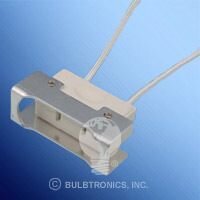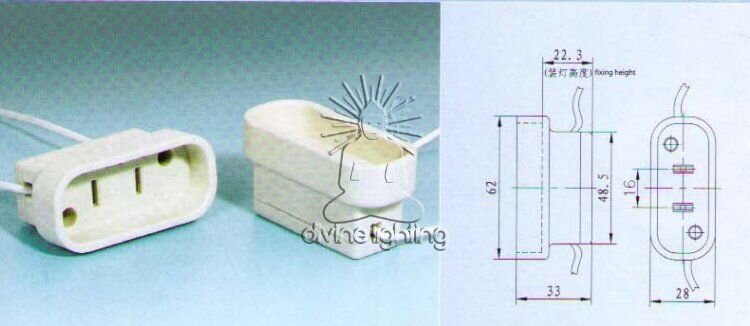You are using an out of date browser. It may not display this or other websites correctly.
You should upgrade or use an alternative browser.
You should upgrade or use an alternative browser.
Corroded Par64 Socket
- Thread starterlcthebeast
- Start date
JD
Well-Known Member
The end prong base on a 64 is more a connector then a standard lamp base. It is outside the envelope proper and behind what would be the reflector. Compared to an HPL, the connector is at a low temperature. I would wire brush it. The socket is only about $4 and the lamp costs almost 8 times that so it's probably worth a try.
lcthebeast
Member
Sounds good, thank you very much
Furthering what JD said, I've found the problem with old Mogul End Prong sockets to be more mechanical failure than electrical. If the can is used as an uplight, and the socket falls off, bending the lamp's prongs slightly can get one through a show until the socket can be replaced.
Buy good sockets.

is preferred over those without metal reinforcement.

Buy good sockets.

is preferred over those without metal reinforcement.

Last edited:
lcthebeast
Member
The sockets have become loose over time for a few of my par cans, and a few more don't even make contact to the lamp. The pars were usually used for down lighting and sides. The sockets here on hand don't have the metal backing. I'll contact my supplier for the better type if these don't last a few years at least. Thanks for the info!
To be proper, if you can pick up a lamp with the socket and give it a light bounce in that lamp staying, it is ok. This assuming the lamp wasn't arc welded to the base - you should start by removing the lamp and inspecting it's prongs for corrosion or arching damage, than do the bounce test.
The aluminum framed socket is the Sylvania #PAR 1 socket. There is a few versions of this socket and yes they are a bit better - though you cannot open it up and adjust the spring tension on them. Spring tension adjustment one thing, arching or corrosion on what's loose another thing that cannot be repaired. Best off not re-tensioning the lampholder.
You can somewhat save many lamps by way of taking a medium to fine grit silicone abrasive grinding wheel for a Dremmel tool to the prongs. This by way of grinding back to flat or cleaning up corrosion as long as you are not taking away too much surface area/thickness of the pin. see mcmaster.com part number 4630a19 for the best tool to use on such a lamp base. This or a very fine grit of sand paper and followed up with 600 grit or crocus cloth to remove the scratches from the pin. A lot of work.
Which ever way you go, remember that if pitted, don't attempt to completely remove such pitting, just get the prong flat and smooth again. Any parts/blobs from the arc welding that's sticking up should be removed in re-surfacing back to the pin's width, but don't dig into the pin more than that. The thinner you make the lamp's pins, the less able they are to get proper tension to the lampholder. That said, contact is about surface area for conducting electricity. A few pitts on this type of lamp won't matter much if planed back to the correct thickness of the pin or slightly less, but more than that is a problem. More about removing what’s rasing the contact above the pin for removal as that would be a smaller surface area for contact, than a few pitts given other surface area on the pin to conduct with.
The pins are probably surface treated, and even if not, your pins are now fresh bright work which will corrode - oxidation don’t conduct that well. What ever you work on needs a coating so as to prevent the fresh bright work from corroding. McMaster part #7437k15 seems to work well in up to 5Kw for treating bright work/electrical contacts against corrosion. Otherwise Kraig Deoxident, I’m told especially the one with copper impregnated in it, also works well.
Sanding without treatment of the surface afterwards is only a temporary fix that will lead to problems later.
The aluminum framed socket is the Sylvania #PAR 1 socket. There is a few versions of this socket and yes they are a bit better - though you cannot open it up and adjust the spring tension on them. Spring tension adjustment one thing, arching or corrosion on what's loose another thing that cannot be repaired. Best off not re-tensioning the lampholder.
You can somewhat save many lamps by way of taking a medium to fine grit silicone abrasive grinding wheel for a Dremmel tool to the prongs. This by way of grinding back to flat or cleaning up corrosion as long as you are not taking away too much surface area/thickness of the pin. see mcmaster.com part number 4630a19 for the best tool to use on such a lamp base. This or a very fine grit of sand paper and followed up with 600 grit or crocus cloth to remove the scratches from the pin. A lot of work.
Which ever way you go, remember that if pitted, don't attempt to completely remove such pitting, just get the prong flat and smooth again. Any parts/blobs from the arc welding that's sticking up should be removed in re-surfacing back to the pin's width, but don't dig into the pin more than that. The thinner you make the lamp's pins, the less able they are to get proper tension to the lampholder. That said, contact is about surface area for conducting electricity. A few pitts on this type of lamp won't matter much if planed back to the correct thickness of the pin or slightly less, but more than that is a problem. More about removing what’s rasing the contact above the pin for removal as that would be a smaller surface area for contact, than a few pitts given other surface area on the pin to conduct with.
The pins are probably surface treated, and even if not, your pins are now fresh bright work which will corrode - oxidation don’t conduct that well. What ever you work on needs a coating so as to prevent the fresh bright work from corroding. McMaster part #7437k15 seems to work well in up to 5Kw for treating bright work/electrical contacts against corrosion. Otherwise Kraig Deoxident, I’m told especially the one with copper impregnated in it, also works well.
Sanding without treatment of the surface afterwards is only a temporary fix that will lead to problems later.
Similar threads
Conventional Fixtures
Sourcing GY9.5 sockets?
- Replies
- 3
- Views
- 545
- Replies
- 14
- Views
- 1K
Users who are viewing this thread
Total: 1 (members: 0, guests: 1)


